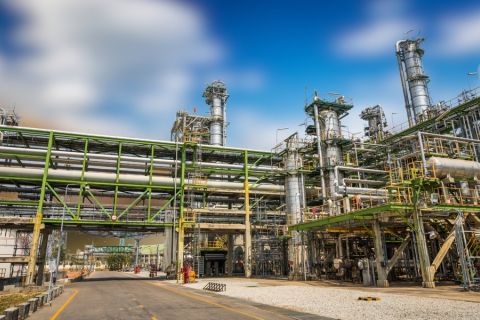The Biden administration unveiled a sweeping plan to slash greenhouse gas emissions from the nation's power industry on May 11, one of the biggest steps so far in its effort to decarbonize the American economy to fight climate change.
The proposal would limit how much carbon dioxide power plants, which are the source of more than a quarter of U.S. emissions, can chuff into the atmosphere, putting the industry on a years-long course to install billions of dollars of new equipment or shut down.
Environmental groups and scientists have long argued that such steps are crucial to curb global warming, but fossil-fuel-producing states argue that they represent government overreach and threaten to destabilize the electric grid.
The proposal sets standards that would push power companies to install carbon capture equipment that can siphon the CO2 from a plant’s smokestack before it reaches the atmosphere, or use super-low-emissions hydrogen as a fuel.
The Environmental Protection Agency projects the plan would cut carbon emissions from coal plants and new gas plants by 617 MMmt between 2028 and 2042, the equivalent of reducing the annual emissions of 137 million passenger vehicles.
"EPA’s proposal relies on proven, readily available technologies to limit carbon pollution and seizes the momentum already underway in the power sector to move toward a cleaner future," Administrator Michael Regan said in a statement.
Regan is to announce more details of the proposal in a speech at the University of Maryland later on May 11.
White House climate adviser Ali Zaidi told reporters the proposal will keep the U.S. on track to meet its goal to achieve net-zero power sector emissions by 2035.
"When you look at what is in the rule and what is proposed we are absolutely in line with the president's goal," he said.
Fighting 'federal overreach'
The proposal, more than 18 months in the making, reflects constraints imposed on the EPA by the Supreme Court, which ruled last year that the agency cannot impose a system-wide shift from fossil fuels to renewable energy, but can regulate plants by setting technology-based standards applied on-site.
An effort by the administration of Democratic former President Barack Obama in 2015 to broadly slash power industry emissions was hung up by legal challenges and eventually repealed in 2019 under the administration of Republican President Donald Trump.
West Virginia Attorney General Patrick Morrisey, who led the legal challenge against the previous EPA carbon rule, said in a statement that his state will "be ready once again to lead the charge in the fight against federal overreach."
America's Power, a group representing utilities that use coal, said the proposal was "designed specifically to cause the premature closure of coal power plants."
"The proposal raises a number of critical legal questions, including whether EPA has the authority to force the use of technologies that are not economically or technically feasible for widespread use," it said.
The proposal is subject to the regulatory rule-making process, including a public comment period. The final rule will have to reflect the public comments and will likely take about a year to be finalized.
The EPA anticipates the proposal will cost the power industry over $10 billion, while yielding health and climate benefits of around $85 billion.
It said the Inflation Reduction Act, President Joe Biden's signature climate bill, will offer billions of dollars in tax incentives and credits that will bring down costs for deployment of CCS and green hydrogen, justifying its decision to base new standards on those technologies.
According to the proposal, new and existing large natural gas plants will be expected to install CCS that removes 90% of their carbon emissions by 2035, or alternatively to co-fire with 30% hydrogen by 2032 and 96% hydrogen by 2038.
New gas-fired "peaker plants," used as backup generation, would face less stringent standards.
For existing coal plants - whose numbers have been declining in recent years - the EPA will consider their planned lifespan. Coal plants that run past 2040, for example, will be required to install CCS technology starting in 2030, while those shutting between 2035 and 2040 would be required to co-fire with 40% gas by 2030.
Regan said the EPA is planning to see some early retirements of older plants as a result of the proposals, but said the impact on electricity prices will be "negligible.”
Environmental groups welcomed the proposal, saying it has been crafted carefully to weather legal fights.
“After two failed attempts to regulate the power sector’s tremendous carbon pollution load, EPA finally gets it just right with this proposal,” said Jay Duffy, litigation director for the Clean Air Task Force.
Recommended Reading
Talos Energy Sells CCS Business to TotalEnergies
2024-03-18 - TotalEnergies’ acquisition targets Talos Energy’s Bayou Bend project, and the French company plans to sell off the remainder of Talos’ carbon capture and sequestration portfolio in Texas and Louisiana.
TotalEnergies, Vanguard Renewables Form RNG JV in US
2024-04-24 - Total Energies and Vanguard Renewable’s equally owned joint venture initially aims to advance 10 RNG projects into construction during the next 12 months.
SLB to Buy Service Firm ChampionX in $7.7B All-stock Deal
2024-04-02 - SLB will acquire ChampionX for $7.74 billion in an all-stock deal that puts a 14.6% premium on ChampionX’s April 1 closing price.
CERAWeek: Exxon Mobil CEO Says Not Trying to Acquire Hess
2024-03-18 - CEO Darren Woods said Exxon Mobil is trying to secure preemption rights over Hess Corp.'s Guyana assets in its dispute with Chevron, not buy the company itself.
ConocoPhillips CEO Ryan Lance: Upstream M&A Wave ‘Not Done’ Yet
2024-03-19 - Dealmaking in the upstream oil and gas industry totaled $234 billion in 2023. The trend shows no signs of slowing, ConocoPhillips CEO Ryan Lance said at the CERAWeek by S&P Global conference.




